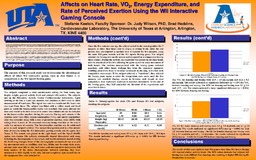
ATTENTION: The works hosted here are being migrated to a new repository that will consolidate resources, improve discoverability, and better show UTA's research impact on the global community. We will update authors as the migration progresses. Please see MavMatrix for more information.
Show simple item record
| dc.contributor.author | Keeton, Stefanie | |
| dc.date.accessioned | 2017-04-06T22:34:24Z | |
| dc.date.available | 2017-04-06T22:34:24Z | |
| dc.date.issued | 2014 | |
| dc.identifier.uri | http://hdl.handle.net/10106/26526 | |
| dc.description | KINE 4400 | en_us |
| dc.description.abstract | INTRODUCTION: Previous experiments indicate in numerous ways that an active video game gives substantially greater health benefits than an inactive video game. The Wii console can be a good contribution to a person’s work out routine, especially if they are incapable of performing other forms of exercise. Using a Wii or other form of active video gaming can result in high VO2 and HR levels for all age groups, and can be beneficial to a person’s health to keep them active and moving. Many of the studies performed using the Nintendo Wii have used Wii Boxing, with significantly high results in many physiological areas, including VO2. However, studies have not been performed to test the reliability of other Wii video games in changing the physiological factors of its user. | en_US |
| dc.description.sponsorship | Faculty Sponsor Dr. Judy Wilson | en_US |
| dc.description.sponsorship | Faculty Sponsor, Brad Heddins | en_us |
| dc.language.iso | en_US | en_US |
| dc.subject | physiological effects | en_US |
| dc.subject | RPE value | en_US |
| dc.subject | Sensormedics machine | en_US |
| dc.title | Affects on Heart Rate, VO2, Energy Expenditure, and Rate of Perceived Exertion Using the Wii Interactive Gaming Console | en_US |
| dc.type | Presentation | en_US |
| dc.publisher.department | Department of Kinesiology, The University of Texas at Arlington | en_us |
| dc.publisher.department | Cardiovascular Laboratory, The University of Texas at Arlington | en_us |
| dc.publisher.department | Exercise Science Research Laboratories, The University of Texas at Arlington | en_us |
Files in this item
- Name:
- Keeton Poster.pdf
- Size:
- 565.6Kb
- Format:
- PDF
- Description:
- pdf
This item appears in the following Collection(s)
Show simple item record


